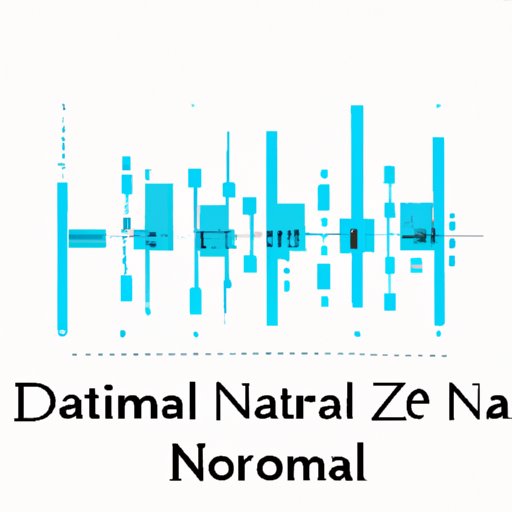
Introduction
Data normalization is the process of organizing data to enhance the performance and efficiency of data analysis. The goal is to streamline the data structure for improved analytics and reporting. In this article, we’ll discuss different techniques for normalizing data, and will explore how it can impact your business.
5 Simple Steps to Normalize Data for Improved Analysis
Let’s dive into the basics of data normalization with this five-step guide:
Step 1: Identify the data that needs normalization
Examine your raw data and pinpoint the areas of redundancy, inconsistency, and anomalies. This will help you plan out a strategy for organizing your data.
Step 2: Create a table with unique values
Using unique identifiers, such as a table name, segregate different aspects of data to make relevant tables.
Step 3: Create a table for verification data
Build a table with check constraints (the constraints on data type) to validate the accuracy of your data. This table acts as a data validation tool.
Step 4: Separate repeating groups
When certain fields contain repeating values, remove them from the main table. Instead, create tables consisting of the unique ID and the resulting values for each of those fields.
Step 5: Normalize additional tables
Normalize similar tables with identical attributes. Create new tables with unique values and link them to each of the main tables.
The result of this process is a well-organized database that is easy to use, update and manage.
Data Normalization: Why it’s Important and How to Do It
Data normalization plays a vital role in ensuring the quality of data. Normalized data avoids duplicate data entries and ensures the accuracy of information. Here are some important reasons why normalization is so important in data analysis:
Importance of data normalization in the process of data analysis
A normalized database makes the search for information much easier and more efficient by filtering out irrelevant information. A well-structured database is much more intuitive to work with, which can significantly boost productivity.
Types of data normalization techniques
Normalization techniques can come in different forms, ranging from first to fifth normal form. The higher the form, the more complex the normalization process becomes.
Detailed explanation of the steps involved in the normalization process
A step-by-step process is essential to carry out the normalization process. Steps consist of segregating data, data type matching, and data validation.
Examples of successful normalization
The results of normalized data speak for themselves. Companies around the world have reported faster and more accurate data analysis after implementing data normalization techniques.
The Pros and Cons of Normalizing Data: What You Need to Know
Like any other process, there are both pros and cons associated with data normalization.
The importance of understanding the pros and cons of normalization
Before normalizing, it’s important to consider the potential benefits and drawbacks.
Advantages of normalizing data in improving data quality and reducing errors
Normalized data is well-structured, clean data. This makes it easier and faster to sort through, which significantly reduces errors in analytical processes.
Disadvantages of normalization in slowing down the processing time
Normalization is a process that takes time and effort. When modifying data structures, there is a potential for data loss, downtime, and the need to rebuild indexes, which can significantly slow down processing time.
Factors that affect the decision to use normalization
Choosing whether to normalize data or not depends on specific business factors, like the size of your dataset and the nature of your business.
Real-World Examples of Successful Data Normalization Techniques
Normalization techniques exist across many industries, and here are some examples of cases that you can study:
Case studies of successful data normalization
Organizations around the world have reported significant transformations in their data analysis accuracy after normalizing their data.
Examples from different business sectors and industries
Normalization techniques are relevant to any business that deals with data. Case studies range from healthcare to retail and financial services.
Interviews with experts who have implemented data normalization techniques themselves
Insights from experts who have implemented normalization techniques can be helpful to guide your normalization process.
Lessons learned from successful data normalization
Successful data normalization is not just about getting data in line; it’s also about streamlining the decision-making process by providing reliable data insights, improving data quality, and reducing the margin of error.
Normalization vs Denormalization: Which is Better for Your Data?
Normalization is not the only way to structure your data. Denormalization serves a different purpose for your data organization and can be useful in some cases. Here’s what you need to know as you weigh the merits of normalization vs denormalization:
The meaning of denormalization and how it differs from normalization
Denormalization is the process of integrating data into one table for faster access and simplified queries.
Comparison of normalization and denormalization
Normalization ensures that data is organized and easily maintainable. Often, however, it can lead to longer processing times. In contrast, denormalization trades speed for maintainability and is useful when you need your data to be accessed more quickly.
Factors that determine the use of each technique
Choosing whether normalization or denormalization is the right choice depends on your business requirements, budget, and data analysis needs.
Real-world examples of normalization vs denormalization
Large enterprises, like Uber, use denormalization to create reports from massive datasets while startups use normalization techniques to help establish well-organized databases.
Conclusion
Normalization is a process that may take time and effort, but it is well worth it. The advantages of normalized data far outweigh the drawbacks. Clean data reduces data analysis errors, speeds up processing times, and prepares you to make informed decisions. As you make your decision of whether to use normalization or denormalization, keep in mind the needs of your data, organization, and business goals to drive your decision.





